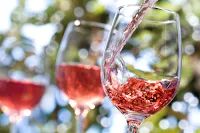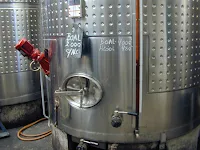 In the wine world, things are changing and true Rosés are again becoming popular, especially with a younger generation now exploring wine in all its forms and glory. In these recession economies, smaller wine producers were looking for a way to maximize immediate cash flow to offset the anticipated but lengthy wait for return on investment from wines aging in the barrel and bottle. Rosés seemed like the right answer to their problem. Since Rosé is best when enjoyed young and takes relatively no time at all to go from grape to bottle, it was a stop gap measure to ensure a winery's bottom line stayed in the black. While hoping for a good response from the market, what took the industry by pleasant surprise was a consumer that embraced the light, crisp and refreshing medium wine, especially in summer and in the hotter climates.
In the wine world, things are changing and true Rosés are again becoming popular, especially with a younger generation now exploring wine in all its forms and glory. In these recession economies, smaller wine producers were looking for a way to maximize immediate cash flow to offset the anticipated but lengthy wait for return on investment from wines aging in the barrel and bottle. Rosés seemed like the right answer to their problem. Since Rosé is best when enjoyed young and takes relatively no time at all to go from grape to bottle, it was a stop gap measure to ensure a winery's bottom line stayed in the black. While hoping for a good response from the market, what took the industry by pleasant surprise was a consumer that embraced the light, crisp and refreshing medium wine, especially in summer and in the hotter climates. Now let me qualify, I am mostly speaking of the American market. In Europe, the scene is very different. When summertime descends upon Europe, Rosé wine is very much the wine of choice and unlike the changing American concept of pink wines (sweet and cloying), true Rosé has never fallen out of favor and has always been enjoyed. Rosé wine originally came from Bordeaux which has been traditionally known for its superb wine making skills, and it is crisp and dry.
 |
| California Central Valley |
It's pink color gave way to a new term. It could not be called white and likewise it was not truly red. This is where the term ‘blush wine’ evolved and to this day, this name is incorrectly associated with Rosé wine. California wineries began producing something they called White Zinfandel. Although it became an enormously popular drink for a few years, it did much to damage the reputation of true Rosés in the minds of America's wine drinkers. White Zin's, as they're called, are very sweet, in comparison to traditional Rosés and are much less versatile.
These early 'Rosé' wines were single dimensional and much too sweet. In spite of that, they were a huge success in America. Americans like sweet. Look at soda, candy, our version of donuts, cupcakes and pastry. The more tooth-achingly sweet anything is, the better Americans seem to like it. Winemakers, needing to make a profit to stay in business, fed the market they were given. That is, until until trendy Americans discovered dry table wines. Suddenly, the interest shifted to wines with classy French names and mass marketed sweet wines declined in esteem, if not in popularity. As with any fad in America, where consumers suddenly become overnight connoisseurs, if you were drinking White Zin and Grenache and you weren't drinking a wine whose name you could barely pronounce, you were no longer considered hip. In those days there were no serious Rosé wines in the American market. True connoisseurs knew about the classic Rosés of Tavel and Lirac, but these wines were rarely found in your local liquor store.
Today, American wine consumers seem to be rediscovering the charm of old world styled Rosés and domestic winemakers are putting their own spin on them. Rosé wines are the fastest growing segment of the American wine market and with good reason. California, Oregon and Washington State are producing some incredible Rosés. While some consumers still like their Grenache and Zin, as palates and wine-drinkers become more mature and educated, the American market is starting to catch up with Europe in its appreciation of this delicate wine. A real Rosé is a dry, crisp, refreshing mouthful of flavor that has a hint of fruitiness. It is a sophisticated and elegant drink that is great at wine pairings and most dinners. Often referred to as a summer wine, the best of these are available from the USA, Italy, Australia, Canada, Spain, France and Portugal.
The Grapes
Made in almost every wine region globally, Rosé wines are produced from a wide variety of grapes, from Mourvedre, Syrah and Grenache, to more unusual grape varieties like Brachetto. Several appellations are noted for their superb rosé wines, including France's Provence and Spain's Navarra regions, where it accounts for more than half of the wines produced. Other places associated with rosé production are Tavel and the Loire Valley. California, Oregon and Washington State are now starting to make their mark, producing some of the best the market has ever seen.Rosé wines, as noted, are typically dry. They should be served chilled and are a refreshing summer beverage. All grape juice is white, no matter what color grapes are used. Winemakers make red wines by leaving the grape skins in with the juice to absorb coloring from them. In the case of Rosé wines, the winemaker allows the skins to soak with the juice only long enough for the wine to take on a pinkish tint; then, the skins are removed and the result is a rosé wine. In the past, it was fairly common to make Rosé wines by simply taking a white wine and adding a bit of red wine to it. Some winemakers thought this could produce interesting wines that possessed some of the hearty character of a red wine while retaining the crispness of many whites. This practice has fallen out of vogue, even in Champagne where it was once quite respected.
Skin contact
 Red-skinned grapes are crushed to what is called must, and the skins are allowed to remain in contact with the juice for a short period, typically two or three days. The grapes are then pressed, and the skins are discarded rather than left in contact throughout fermentation (as with red wine making). The skins contain much of the strongly flavored tannin and other compounds, which leaves the taste more similar to a white wine. The longer that the skins are left in contact with the juice, the more intense the color of the final wine.
Red-skinned grapes are crushed to what is called must, and the skins are allowed to remain in contact with the juice for a short period, typically two or three days. The grapes are then pressed, and the skins are discarded rather than left in contact throughout fermentation (as with red wine making). The skins contain much of the strongly flavored tannin and other compounds, which leaves the taste more similar to a white wine. The longer that the skins are left in contact with the juice, the more intense the color of the final wine.Saignée
Rosé wine can be produced as a by-product of red wine fermentation using a technique known as Saignée, or bleeding the vats. When a winemaker desires to impart more tannin and color to a red wine, some of the pink juice from the must can be removed at an early stage. The red wine remaining in the vats is intensified as a result of the bleeding, because the volume of juice in the must is reduced, and the must involved in the maceration is concentrated. The pink juice that is removed can be fermented separately to produce Rosé.Types
 |
| Bordeaux |
Pairing a Rosé
Rosé wines offer interesting opportunities in matching with food because they offer an incredible versatility. They shine in cases where a white wine is not enough and a red wine is simply too much. In addition, thanks to the low content in tannins combined with their appreciable crispness, they can be served to the same temperatures as white wines. It is often said Rosé has the same aromas of red with the advantage of being served as would a white white wine, therefore they are characterized by excellently agreeable and pleasing aromas. The versatility of Rosé wine in the matching with food is wide and they are a perfect foil to appetizers, pasta, rice, fish, meat, as well as cheese. One of the main characteristics of Rosé is their freshness in aromas, usually the same which are typically found in young red wines, however, just like any other type of wine, before proceeding with matching, it is best to know the specific characteristics of every wine. Compared to white wines, rosés are usually less acid and have a higher roundness, factors which also depend on the technique used in their production. When compared to red wines, they have a lesser structure and a lower astringency. In general terms, Rosé wines do not have a high alcohol by volume percentage, a factor that, of course, also depends on the specific conditions
 of the wine and its balance. Thanks to the smoothness of Rosé, it is great with pasta, fish, in particular fish soups, and roasted fish that is richly seasoned and spiced. Rosé is also suited for mushrooms and soft cheeses.
of the wine and its balance. Thanks to the smoothness of Rosé, it is great with pasta, fish, in particular fish soups, and roasted fish that is richly seasoned and spiced. Rosé is also suited for mushrooms and soft cheeses. Rosé can even stand up to some meats, particularly white meats such as chicken or pork. In summer, I find them great as an aperitif, though you may want to let them warm a bit above the temperature that you would serve a chardonnay. This slight elevation in temperature brings out the delicate sweetness of the wine all the more. Rose's are even good with cold cuts, whether lean or fatty, as well as with preparations based on vegetables.
Rosa Regale from Banfi
Brachetto 100%.
PRODUCTION TECHNIQUE
Cold red-grapes skin contact for 4 to 5 days allows the wine to develop its characteristic color, aroma and complexity. The wine is then filtered and stored at 0°C. Re-fermentation follows in stainless steel tanks in the Strevi cellars, where this special wine achieves its final sweetness and sparkling character.
 DESCRIPTION
DESCRIPTIONCOLOR: light ruby red. Lively pink mousse with a persistent perlage.
BOUQUET: intense, aromatic, varietal with hints of Bulgarian rose.
TASTE: soft and elegant with berry flavors and a touch of almond and nutmeg.
WINEMAKER’S NOTES
A soft red sparkling wine, made from Brachetto. This extremely aromatic, complex and historical grape variety grows only in the area of Acqui Terme, in Southern Piedmont.The cold maceration of the grapes, followed by a soft pressing, allows the extraction of the typical intense aromas from the skins and gives to the wine its characteristic light ruby red color. Very pleasant and extremely elegant.
FOOD PAIRINGS
This wine matches perfectly with fresh strawberries, fruit cakes, fruit salads, pastries and chocolates. An ideal aperitif as well.
Rosé is a great summer wine, cool, refreshing and delicious, But don't take my word for it. Do a tasting, find the one you like and add it to your cellar or cooler. You'll be glad you did.
Bon Appetit,
Image sources: FreeDigitalPhotos.net cltampa.com www.rosaregale.com www.myrecipes.com













